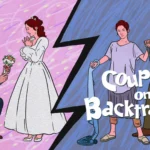
My Sunday morning kids’ group (aged 4–11) is scandalised.
“I didn’t know that was in the Bible!” Ming exclaims, eyes shining.
“Eww, that’s gross,” Valerie agrees, wrinkling her nose. “But it’s fair,” she adds a moment later, “when you think of all the horrible things Ahab and Jezebel did.”
Wanhui hasn’t taken her eyes off the visual aids since the story started. At last she breaks her silence. “That was just like watching a movie!”
We’re working our way through 1 and 2 Kings, a story at a time, and if you’ve ever regarded certain parts of the Bible as “kid-unfriendly”, maybe we’ll bust that myth!
“I Didn’t Know That Was in the Bible!”
As parents, most of us don’t know the Bible as well as we ought to—and as well as we’d like to—if only to be able to tell it faithfully to our children.
Part of the problem is that we ourselves may have grown up with cute Bible stories and little else:
A family herds cutesy animals two by two into a giant boat, where everyone is kept safe from a huge flood. Or, a gifted young man spends a night among cuddly lions that miraculously don’t harm him. Or, a beautiful young woman uses her influence as a queen to save her people. And so on, through all the popular Bible characters and episodes.
Part of the problem is that we ourselves may have grown up with cute Bible stories.
Now, don’t get me wrong—there’s nothing wrong with any of those stories. They all show that God cares for us and helps us do the right thing.
Moreover, stories are a great introduction to the Bible, because curious minds always want to hear what comes next and how the story ends.
And yet, here are four reasons why, when it comes to nurturing our children in their faith, cute Bible stories aren’t enough:
1. A Lot Gets Left Out
We parents, along with publishers and illustrators, want to keep our kids engaged and interested; we want to promote Christian moral values without frightening or confusing a young audience.
And so we favour brightly coloured, adorable illustrations and relatable characters, and we are often tempted to edit out troubling or uncomfortable details.
You may have seen, for instance, Psalm 23 illustrated with adorable sheep roaming green pastures in the care of a kindly shepherd. Rarely in children’s versions does anyone mention a dark valley of death (verse 4) or the nearness of enemies (verse 5).
Yet, as Christian mum, speaker and writer Elizabeth Laing Thompson has pointed out, suffering is present in Psalm 23, and hardship is not a punishment reserved only for faithless people.
We are often tempted to edit out troubling or uncomfortable details.
“One minute we’re following our loving Shepherd down paths of righteousness; the next we’re in the valley of the shadow of death. Do you get what this means? Sometimes God’s righteous paths take us to the dark places. Sometimes God Himself leads us into the valley.”
The Christian life, Thompson concludes, is not so much the blissful, easy experience we all want, but the path that God in His wisdom has chosen, that tests our faith and grows our character, through pain if necessary.
Ultimately, our storytelling falls short if we give our children morality or positive thinking rather than the gospel.
With reading or retelling the Bible, selecting only the parts that we think will appeal to children would mean glossing over or ignoring a large part of the Old Testament, as well as numerous New Testament passages that involve death, violence, punishment or suffering.
But some might say, “So what? Can’t the gaps be filled in later?” After all, in academic curricula we deliver age-appropriate content; algebra is not taught to toddlers but saved for later, when teenage brains are relatively more mature.
The Bible, however, is not like a mathematics textbook, where certain components can be understood and used in isolation. The Bible presents a worldview in which God, humankind and the rest of creation are interconnected and interacting with one another, and this brings me to the second reason why cute Bible stories alone aren’t enough.
2. They Misrepresent Reality
When my children come to me with complaints that life isn’t fair or all plain sailing, I enfold them in loving arms and agree, “No, it really isn’t.”
I empathise with their hurt feelings and right whatever wrongs I can, but ultimately I want my children to recognise that we live in a fallen world.
I do my children—and God—a disservice if I give them only a compendium of fluffy tales.
For them—and anyone else—to come to a saving faith in Jesus, they must first see that God’s Word is relevant and accurate in its depiction and assessment of the real world, a world where bad and sad things do happen.
Brokenness is on the inside, too. It won’t be long before any child encounters injustices such as dishonesty or bullying; the pain of betrayal or broken friendships; and even the death of loved ones.
I do my children—and God—a disservice if I give them only a compendium of fluffy tales, because they quickly outgrow these and assume that the Bible is inadequate in addressing real-world problems and the lies in our hearts.
But the Bible is not powerless! Rather, “the word of God is alive and active. Sharper than any double-edged sword, it penetrates even to dividing soul and spirit, joints and marrow; it judges the thoughts and attitudes of the heart” (Hebrews 4:12).
God’s Word is relevant and accurate in its depiction and assessment of the real world.
The Hebrews writer describes the power of Scripture to convict the human heart of our personal rebellion against God. In order for Scripture to achieve this, God has intentionally given us far more than cute Bible stories in His Word.
The background to Hebrews 4:12 is, in fact, a story told in Exodus 17 and recounted in Deuteronomy and Psalms, concerning God’s anger towards the Israelites who turned against Him at Meribah. The incident, says the Hebrews writer, serves as a warning to us, “so that no one will perish by following [Israel’s] example of disobedience” (Hebrews 4:11).
3. They Don’t Fully Convey the Character of God
In the Bible, we see the character God from all His interactions with the world: that He is not only merciful, faithful and full of grace, but also all-powerful, righteous, hating evil and coming to judge all sins.
Take for example the story of Ananias and Sapphira, which unfolds in the early church.
God is not okay with the wickedness and rebellion of humankind.
In the glowing community of Acts 4:32–35, sin was still alive, and Ananias and Sapphira were struck dead because they were dishonest not only towards their fellow believers but towards God (Acts 5).
I’ve heard it recommended that this story not be taught to younger children because the anger of God displayed against people who sin is frankly scary, but let me tackle the idea of handling sensitive topics faithfully and responsibly in my next article.
For now, I want to point out that it’s precisely the most troubling details that help us understand that evil and sin are part of life in a fallen world; that God is not okay with the wickedness and rebellion of humankind; that He is not a helpless bystander; that He has sent Jesus to save us from the penalty for sin.
With that, we come to the fourth and most important reason why we must understand and teach our little ones the whole message of the Bible.
4. They Don’t Give Us the Full Message of God’s Word.
Bible stories are like parts of a jigsaw puzzle—they aren’t supposed to stand alone. Unless they are retold with reference to the Bible’s overall message, we can easily misunderstand them to be all about us, the satisfaction of our wants and the pursuit of our goals.
For instance, you may have come across materials that encourage kids—and grown-ups—to overcome our greatest problems by rising above adverse circumstances (like how Joseph rose from slavery to become Pharaoh’s most trusted advisor); or by using the strengths we already have, to fight our fears (like how David used the pebbles on the ground against his huge opponent).
Read as a whole, the Bible’s stories aren’t really about us; they’re about Jesus our Saviour and Lord.
But Joseph and David are no ordinary persons, and their stories are not in the Bible to coach us for personal success. They are two of many “shadows” or types—flawed, human representations of the reality that was to come, Jesus, the perfect Saviour King.
Genesis 50:20 makes it clear that God’s plan of rescue was behind the remarkable events in Joseph’s life.
Similarly, 2 Samuel 7 helps us see that God enabled David’s victory over Goliath and the Philistine occupants of the land because God promised His people a permanent home and everlasting peace, a promise partially fulfilled during David’s reign and foreshadowing Jesus’ eternal kingdom.
Bible stories are like parts of a jigsaw puzzle—they aren’t supposed to stand alone.
Read as a whole, the Bible’s stories aren’t really about us; they’re about Jesus our Saviour and Lord; they’re about God’s great purposes in saving us to live as His people. When Jesus appeared to His disciples after His resurrection, “beginning with Moses and all the Prophets, He explained to them what was said in all the Scriptures concerning himself” (Luke 24:27).
All of God’s Word and its 66 books and hundreds of narratives are really one story, about one Person, one Saviour: “The Messiah will suffer and rise from the dead on the third day, and repentance for the forgiveness of sins will be preached in his name to all nations, beginning at Jerusalem” (Luke 24:46–47).
Telling Our Children the Full Story
It is vital that we and our kids learn to read the Bible and its hundreds of stories in their proper context because it is not cute stories but the gospel of our Lord Jesus that has the power to bring about salvation and equip us to live as Christians (2 Timothy 3:15–17).
Ultimately, our storytelling falls short if we give our children morality or positive thinking rather than the gospel.
Parents, if you are feeling daunted by this task, please join me in asking God for diligence and wisdom.
I am by no means any guru; I’ve learned from godly parents and teachers who went before me, whose children and students have grown up responding to the Scriptures in faith, by God’s grace. You’ll also find in the next post* some tips for getting started.
*Check out Karen Kwek’s next article in this two-part series, Why Cute Bible Stories Aren’t Enough Part II.
Names in the first four paragraphs of this article have been changed to protect the privacy of individuals.



